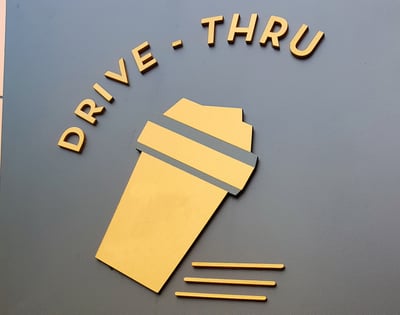The must-have restaurant accessory? A drive-thru lane.

Convenience, speed, safety perceptions and barriers to in-person dining all have drawn consumers to the drive-thru window. KFC , Del Taco and Dunkin’ are just a few of the quick-service brands that are planning drive-thru-only restaurant models, without in-person dining. And other restaurants are just now entering this space: “We’re seeing brands that would never in a million years embrace the drive-thru, embracing the drive-thru,” Adam Chandler, author of Drive-Thru Dreams, told The Counter.
What should restaurant operators know about the evolution of drive-thru dining? Here are a few key takeaways.
Mobile ordering is king.
“The typical drive-thru is an impulse order, traditionally,” Darren Tristano, CEO of FoodserviceResults, said in a recent webinar on QSR’s Drive-Thru Study. “It’s pull up, order, pay, get your food, move on. But it’s obviously evolving.” Of the drive-thru customers surveyed, 42% of consumers had ordered online or through an app for curbside pickup in the past 30 days. 34% had ordered online for delivery; 30% for in-store pickup; and 18% via a third-party site or app.
Whether your business launches its own mobile app or uses a platform that’s already available, make sure it includes customers’ must-haves: easy payment and re-ordering, real-time order status updates, and loyalty rewards.
Dinner’s a winner.
Remember when drive-thrus were crammed with office workers mid-day? Now, the evening has taken over. In QSR’s survey, 41% of consumers said they were likely to visit a drive-thru for dinner. 34% said lunch, and 11% said breakfast. Just 5% said they’d hit the drive-thru for late-night, beverage-only, and snack visits.
“The dinner daypart has emerged as a much stronger play for drive-thru,” Tristano said. “We’re seeing higher check averages, larger purchases for bigger occasions – these would be family occasions.” Parents want to feed their families for less than delivery, so consider offering meal deals for them — such as the KFC $30 Family Fill Up or Burger King’s $12.99 Family Bundle.
Fast casual and casual dining restaurants are considering drive-thru options.
The survey found that 57% of respondents (and notably, 65% of millennials) agree they’d be more likely to order from a fast-casual restaurant if it had a drive-thru. Tristano predicts that more fast casuals and casual dining establishments will compete with QSRs for real estate and drive-thru orders.
Drive-thru service doesn’t always work well with fast-casual or casual dining menus, which are often made to order and take longer to prepare. You may need to trim the menu, provide parking places, keep customers informed about wait times and bring food carside.
Drive-thrus are just one part of the new food pickup/eat-in paradigm.
Sweetgreen, the popular purveyor of healthful salads and bowls, is trying what QSR Editor Sam Oches calls “a choose-your-own adventure” approach: a drive-in area where people can use intercoms to order from their cars, a drive-thru lane for mobile orders, walk-up food pickup and outdoor dining. They’re not alone: Newly constructed drive-thrus, like Shake Shack’s, incorporate multiple lanes for impulse orders and app pickup orders.
If you plan to incorporate drive-thru lanes in a new location, think about all the options your customers want. Plan for your future customers, too. The survey found that 61% of millennials would prefer to pre-order and use a pickup-only line, but only 38% of Gen-Z customers agree. Younger, urban and car-free consumers may prefer other ways to grab their food.
No drive-thru? No problem.
If your restaurants’ location or physical construction doesn’t allow for a traditional drive-thru, don’t panic. Get creative!
“Maybe you just need a parking lot,” Oches says. He cites Red Door Grill, a five-location chain in Kansas City, that rapidly pivoted to parking-lot service. The restaurant reduced its menu to items that could be made in 5-7 minutes and placed employees in the lot with POS tablets.
Luther Burger in Richmond, Virginia, known for its vegan burgers and donut burgers, set up an enclosed kiosk in the lot where an employee takes orders from drive-up customers. Customers are directed to a parking spot, and an employee brings out their food.
Stay focused on the basics.
Customers’ expectations for drive-thru service haven’t changed. They want speed, convenience and accuracy. They want their food to be freshly made and served with a smile. Equipment from Hamilton Beach Commercial can help you meet these high expectations, with beverage automation and high-performance blenders.
Discover Hamilton Beach Commercial’s full line of commercial foodservice equipment for quick-service restaurants.


